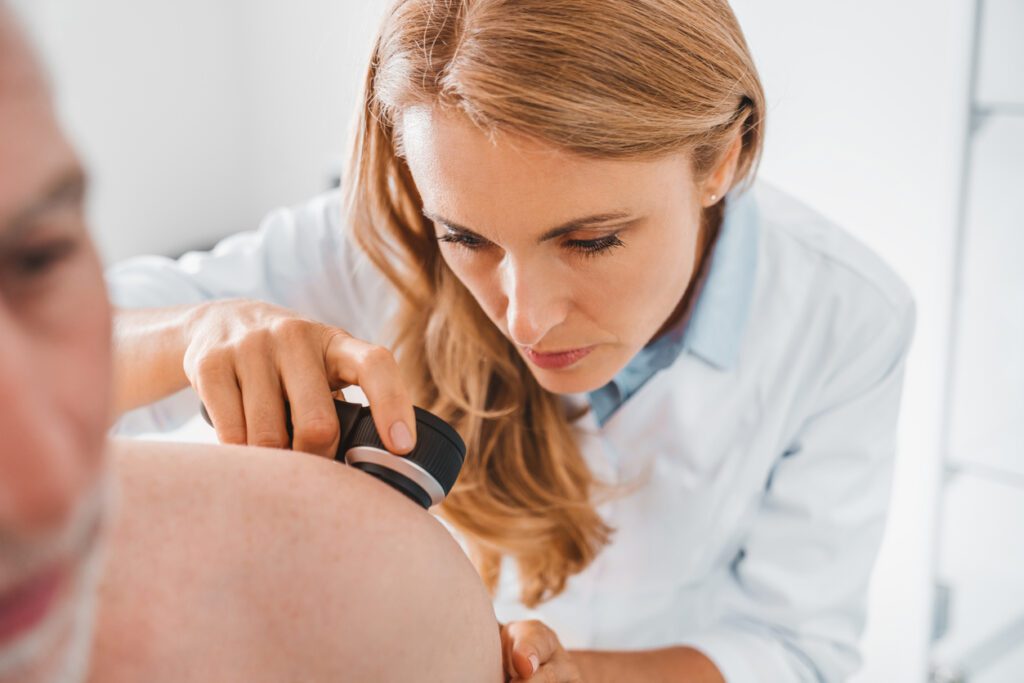This is one of the more serious blog posts I have written, but it is important to share! My husband, Jim, learned he had skin cancer, a melanoma, during a regular yearly exam with his dermatologist. Melanomas are the most dangerous form of skin cancer; luckily, his was detected early. I want to stress that the melanoma on his face looked very insignificant.
Melanomas are one of the most severe forms of skin cancer, and medical intervention is required to remove them. The surgical process involves a dermatologist removing melanoma growth from the skin, followed by several stitches to close up the wound. If the melanomas are detected early and all affected tissue is removed. Then, in that case, the prognosis is incredibly favorable. Wearing protective sunscreen when outside can significantly minimize the chances of developing melanoma. Unfortunately, even if you are proactive and generously apply sunscreen, you can still develop melanoma.
The medical-surgical process for melanoma removal depends on the size and location of the melanoma. Usually, a small melanoma will be removed through excisional surgery with an elliptical incision surrounding the melanoma. Larger melanomas require extensive tissue removal, sometimes called “wide local excision.” With this procedure, some melanomas may require additional treatments such as chemotherapy or radiation therapy.
Skin cancer is one of the most common types of cancer worldwide. It affects millions of people annually, and its incidence rate is rising. One of the deadliest skin cancers is melanoma, which can be fatal if left untreated. Therefore, it is essential to take preventive measures against skin cancer.
One such measure is to see a dermatologist regularly for skin checks and skin exams to detect skin cancer early on. Dermatologists specialize in skin health and can provide important information about the different types of skin cancer, including melanoma. They can also determine when regular self-exams should be done between office visits to monitor any changes or irregularities in moles or other skin lesions that could indicate skin cancer.

In addition to visiting a dermatologist regularly, it is essential to use sunscreen and practice safe skin habits outdoors to reduce the risk of skin cancer. Sunscreen with at least 30 SPF (Sun Protection Factor) should be applied daily, even on cloudy days. Furthermore, wearing protective clothing and avoiding direct sun exposure during peak hours can help protect skin from harmful UV rays that could cause skin damage over time.
There are three main types of Skin cancers: basal cell carcinoma, squamous cell carcinoma, and melanoma.
- Basal cell carcinomas usually appear as small bumps or lesions and rarely spread beyond their original site.
- Squamous cell carcinomas are more serious than basal cell skin cancers and can spread to other organs if not treated immediately.
- Melanoma is the deadliest skin cancer, as it has a high potential for metastasizing throughout the body. It usually presents as an irregularly shaped mole with uneven borders and multiple colors and can be fatal if left untreated.
Skin cancer treatment for facial cancers – Metrolina Dermatology. https://www.metrolinadermatology.com/skin-cancer/skin-cancer-treatment-facial-cancers
People can drastically reduce their risk of developing skin cancer by following simple preventive measures and being aware of any skin changes that could indicate skin cancer. It is also essential to recognize the signs of skin cancer to get prompt treatment should any irregularities occur. Early detection is critical for successful treatment, so visiting a dermatologist regularly for skin checks is advised to detect skin cancer early on.
Therefore, it is essential to stay vigilant and take necessary precautions against skin cancer to maintain skin health and reduce the risk of developing skin-related illnesses.
I encourage you to see a dermatologist if you haven’t already done so.
The main image for this blog post and the other photo are from the iStock.com library. I chose not to include any personal photos of Jim’s melanoma.
Thank you for reading this blog post, and if you have any questions or comments, please leave them in the Comments section below.
© 2019 I Don’t Know All The Answers, Nikki Mastro
All of my photographs and documents are Copyrighted.


John has had skin cancer on several parts of his body. He had a melanoma on his left forearm which was so large, a surgeon had to remove. He has had squamous cell on his chest and several other spots on his body. He goes to the dermatologist every 6 months, sooner if he spots something suspicious. Some people ignore these spots thinking they are “nothing.” Not true and you are so right – GO TO A DERMATOLOGIST! Thanks for the article.
Thank you, Karen, for your response! Testimonies like yours will have a far greater impact than my blog.